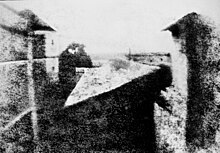Heliography


The heliography or Heliographie (from the French portmanteau Héliographie formed from Greek. Ἥλιος hélios "sun" and γράφειν Graphein "drawing, writing (be)") is that of Joseph Nicephore Niépce developed methods that produce the first lasting in the history of photography Images could.
Niépces had already started his experiments in 1811, and in 1822 he had made the first lightfast heliographic copy of a graphic sheet. The experiment of 1826 is considered to be the actual hour of birth of photography, because Niépce succeeded for the first time in creating permanent photographic images using the camera. Niépce worked with Louis Daguerre from 1829 . The official year of birth of photography is 1839 with the public presentation of the daguerreotype .
Technology of heliography
In 1826, Niépce captured a view from the window of his study with a camera obscura and an asphalt- coated, 21 cm × 16 cm polished tin plate. The exposure time was about 8 hours. The asphalt was hardened under the influence of light, so that during the subsequent "development" with lavender oil and petroleum only the less exposed areas of asphalt were removed. Thus the picture was "fixed" and lightfast at the same time. Niépce's actual goal was to etch these plates in order to obtain prints from them by printing, which he only succeeded in doing with contact copies of line art (copperplate engravings, etchings). He also used lithographic stones , glass plates, tin , zinc , copper and silver plated plates. In later experiments, he vaporized the developed plates with iodine to blacken the shaded areas, then dissolved the remaining asphalt layer with alcohol and thus obtained direct positives that were richer in contrast . Although the heliography did not become ready for use during Niépce's lifetime, it was later further developed by his nephew Claude Félix Abel Niépce de Saint-Victor . In 1855, with the help of the engraver Lemaître, he succeeded in etching the heliographies and making prints from them, which laid the foundation for the later heliogravure process.
Other early photographic processes
- Daguerreotype (around 1835)
- Calotype (also talbotype , around 1835)
- Ambrotype (around 1850)
- Ferrotype (also known as sheet metal photography ; around 1850)
- Wet collodion plate (around 1850), history and development of photography
- Wothlytypia (1864)
Note: heliographic coordinates are an astronomical term.
literature
- Wolfgang Autenrieth: New and old techniques of etching and fine printing. From witch's meal and dragon's blood to the photopolymer layer. Tips, tricks, instructions and recipes from five centuries - An alchemistic workshop book 6th edition, Krauchenwies 2010, ISBN 978-3-00-035619-3 ( table of contents , (→ excerpts online) )
- Helmut Gernsheim : History of Photography. The first 100 years (= Propylaea art history. Special volume 3). Propylaen-Verlag, Frankfurt am Main et al. 1983, ISBN 3-549-05213-8 .
- Wolfgang Baier: History of Photography. = Source representations for the history of photography. 2nd Edition. Verlag Schirmer / Mosel, Munich 1980, ISBN 3-921375-60-6 .
- Ernst Lietze: Modern heliographic processes. A manual of instruction in the art of reproducing drawings, engravings, manuscripts, etc., by the action of light. For the use of engineers, architects etc. Van Nostrand, New York NY 1888 (Reprint: Visual Studies Workshop, Rochester NY 1974, ISBN 0-87992-001-7 ).
- Josef Maria Eder : Detailed handbook of photography. Volume 1, Part 1: History of Photography. Half 1–2. 4th, completely revised and enlarged edition. Knapp, Halle (Saale) 1932.
- The heliography (p. 90ff.). In: Ludwig Pfau : Kunst und Gewerbe , Ebner & Seubert, Stuttgart, 1877